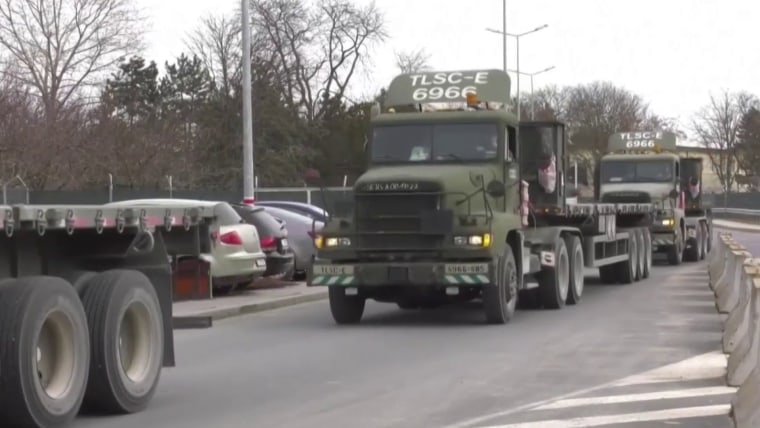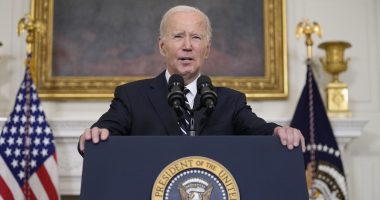Where does Russian President Vladimir Putin plan to stop?
That is the question that has thrust the United States and its allies into an uncertain new era, cleaving a divide between East and West not seen since the Cold War and conjuring up fears of worst-case scenarios that were difficult to comprehend days ago.
Putin always knew that the U.S. and Western Europe would not step in militarily when he launched his invasion last week; the White House and other governments have always made it clear they would not go toe-to-toe with Russia, the country with the world’s largest nuclear arsenal, over the defense of Ukraine, which is not a member of NATO.
But the same is not true for Poland, Lithuania, Latvia and Estonia, which are all members of the alliance. That means, in theory, they would enjoy the protection of NATO’s Article 5 — the tenet that suggests all allies, including the U.S., would come to the aid of any member that comes under attack.
For the Baltic states in particular, Putin’s threats against Ukraine were seen as a de facto threat against them. He said he sees Ukraine as historically Russian land — a territorial claim that he could make over them too.
This trio of northern European nations — Lithuania, Latvia and Estonia — does not have the same cultural and linguistic ties to Russia that Ukraine does. But they were ruled by Moscow for much of the past 200 years, first under the Russian Empire and then under the Soviet Union.
They all voted for independence from the USSR in 1991 and joined NATO in 2004 — a development on Putin’s long list of grievances against the West.
Putin’s aim of “reversing history and going back to Russia’s status as it was over 100 years ago also directly affects other neighbors,” Keir Giles, senior consulting fellow at Chatham House, a London think tank, told NBC News last week. “This means Estonia, Latvia, Lithuania, Poland and Finland.”
If the Russian president’s campaign succeeds in Ukraine, Putin could turn his attention to Moldova or Georgia, two former Soviet republics that today have breakaway regions occupied by Russian troops, according to Karin von Hippel, a former nonpolitical senior adviser at the State Department under President Barack Obama.
Neither Moldova nor Georgia are NATO members. But if Putin “starts to slowly expand his empire there will be several other places that are in NATO that are going to be getting extremely stressed out,” said von Hippel, now director-general of the Royal United Services Institute in London.
Before the Russian invasion of Ukraine, that scenario seemed unthinkable.
In November, British Prime Minister Boris Johnson told lawmakers that “we have to recognize that the old concepts of fighting big tank battles on European land mass are over.”
By launching his attack on a European democracy, Putin has shattered that preconception.
Russian forces have met stronger than expected resistance in Ukraine. But Western intelligence officials and experts believe Putin’s plan is to take control of the capital, possibly to install a new regime more amenable to Moscow.
The conflict has also seen Putin further entrench himself in Belarus, his ally that borders Poland and Lithuania, and that looked more like a satellite state after it hosted some of the Russian troops that rolled toward Kyiv.
There is great uncertainty about how far west in Ukraine the Russian leader intends to go — and Washington’s allies in the Baltics are alarmed that he may not stop at Ukraine at all.
Lithuania announced a state of emergency Thursday, and Estonia and Latvia called for urgent security talks. All three Baltic nations have said they will ban Russian commercial flights from their airspace.
Leaders of those governments have in recent weeks shuttled to European capitals to warn that failure to deter Putin in Ukraine could embolden him to extend his reach elsewhere.
“The battle for Ukraine is a battle for Europe,” Lithuanian Foreign Minister Gabrielius Landsbergis warned earlier this month. “If Putin is not stopped there, he will go further.”
Others aren’t quite so concerned.
Adm. James Stavridis, former Supreme Allied Commander of NATO, pointed to the alliance’s relative military strength and said last week he was confident that “Putin will not cross a NATO border the way he’s gone across this Ukrainian border.”
Still, for the first time in its 73-year history, NATO said in the wake of Putin’s invasion that it was deploying its combat-ready “response force” to Eastern Europe and reminded Russia that NATO’s commitment to Article 5 was “iron-clad.”
It has been a clarifying moment for the transatlantic alliance, which struggled to find relevance after the Cold War, and in recent years had been called “obsolete” by former President Donald Trump and “braindead” by French President Emmanuel Macron.
Source: | This article originally belongs to Nbcnews.com










